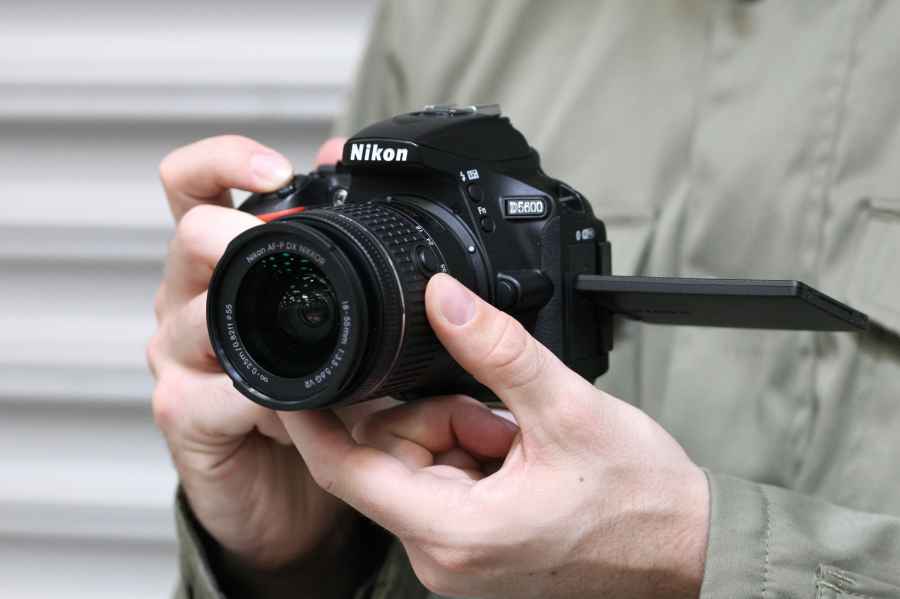What is the Nikon D5600?
The Nikon D5600 is a direct replacement for the two-year-old Nikon D5500 that has now been discontinued. The new model is primarily targeted at photography enthusiasts looking to buy their first DSLR and who have a little more money to spend, along with existing owners of older entry-level Nikon DSLRs looking to upgrade.
Nikon D5600 – Features
In terms of its headline specifications, the D5600 is almost identical to the D5500 it replaces. That said, the newer model does benefit from a few useful new features. Chief among these is the addition of Nikon’s proprietary SnapBridge technology that uses Bluetooth Low Energy (BLE) tech for wireless image-transfer duties between the camera and a connected smartphone or tablet.

A timelapse mode has also been added, and the D5600 comes with a brand-new kit lens in the shape of the Nikon AF-P DX 18-55mm f/3.5-5.6G VR. This employs a retractable design for added compactness and comes with Nikon’s Vibration Reduction (VR) image-stabilisation technology built in. Unlike the AF-S DX 18-55mm f/3.5-5.6G VR II that came with the D5500, there is no VR on/off switch located on the lens itself – you’ll need to use the in-camera menu instead. Neither is there an MF/AF switch, although manual override is available by default.
Aside from these subtle additions, there isn’t a great deal of difference between the D5600 and its predecessor. In keeping with the D5500, the D5600 is fitted with a 24.2MP APS-C CMOS sensor. This provides ample resolution for larger prints, along with a generous degree of image-cropping flexibility. As with previous models, the sensor forgoes an optical low-pass filter in order to maximise sharpness and fine detail, and the D5600 also employs the same Nikon EXPEED 4 image processor that was used in the D5500.

Shutter speeds range from 30-1/4000sec, while sensitivity ranges from ISO 100-25,600. Still-image capture options extend to large (24MP), medium (13.5MP) and small (6MP) JPEGs processed in-camera, while those looking for more versatility in post-production can choose between 12-bit and 14-bit lossless raw. Video capture is possible at 1080p Full HD or 720p HD at up to 60fps, and the D5600 also sports a dedicated microphone jack, although there’s no headphone jack.
The main addition to the D5600 is undoubtedly SnapBridge, which uses Bluetooth Low Energy (BLE) technology to establish an always-on connection to a smartphone or tablet. It’s designed to automatically transfer all captured images from the D5600 to your device for sharing, but you can choose to manually transfer specific ones yourself. They can be transferred at their original size, or limited to 2MB per image in order to save memory. The main benefit of SnapBridge is that Bluetooth consumes less power than Wi-Fi, thereby extending the camera’s battery life. You’ll need to install the SnapBridge app on your phone first, which is free to both Android iOS users.

Unlike the cheaper D3400, which only uses Bluetooth connectivity, the D5600 also includes Wi-Fi. This allows you to use SnapBridge as a remote control for your camera, complete with a live view feed. You can select a point of focus by tapping the viewfinder on your smartphone’s screen, but you can’t change any key camera settings remotely via the SnapBridge app. This feels rather primitive in contrast to other manufacturers’ systems, which all let you change shutter speed, aperture, ISO and so on directly from your smartphone.
Nikon D5600 – Build and design
The D5600 is one of the smallest and lightest DSLRs on the market. It’s even slightly smaller than the cheaper Nikon D3400. While overall build quality obviously isn’t in the same league as more expensive Nikon DSLRs, its polycarbonate shell feels robust enough to soak up the odd minor knock. It isn’t weather-proofed so you’ll want to take care when using it in the wet.

Despite its relatively small size, the D5600 offers a deep finger grip that, combined with the ridged thumb rest on the back, offers a reassuringly secure grip. Overall, it feels nicely balanced in the hand and handles very well. General operation is quick and efficient thanks primarily to the camera’s large display and responsive touchscreen. My only minor gripe is that it’s easy to move the active AF point inadvertently with your nose when holding the camera at eye level, but the touchscreen can be turned off if you find this a problem.

Buttons and controls are generously spaced and clearly labelled, although unlike all its main rivals, the D5600 lacks any buttons that provide direct access to commonly used settings such as ISO, AF mode and white balance. If you want to change any of these, by far the quickest way is to press the ‘i’ button, which takes you to a streamlined settings interface, from where you can access and change the most commonly used controls using the touchscreen.
Nikon D5600 – Performance
The D5600 is equipped with a slightly larger-than-average 3.2-inch rear display – all its main rivals sport 3-inch monitors. This is of the side-hinged, vari-angle design that allows you to position the screen at just about any angle you can think of, as well as fold it in towards the camera for added protection. Above the display the D5600’s optical viewfinder provides a bright and clear view of 95% of the frame, with key shooting information displayed directly below.

Nikon AF-P DX 18-55mm f/3.5-5.6G VR, 1/30sec at f/8, ISO 100
Autofocus is taken care of via Nikon’s Multi-CAM 4800DX module and employs 39 individual AF points, including a block of nine cross-type AF points in the centre. This works extremely well and is certainly a step up from the 11-point AF system of the cheaper D3400, delivering speedy and accurate phase-detection autofocus through the viewfinder.

Nikon AF-P DX 18-55mm f/3.5-5.6G VR, 1/200sec at f/8, ISO 100
While the D5600’s live view AF isn’t as lightning-fast as the Dual Pixel AF technology that underpins the Canon EOS 800D, it’s not far behind and still impressively quick. The new 15-55mm AF-P kit lens is also silent when focusing, which means there’s no sound to be picked up when shooting video.
With its maximum burst speed of 5fps, continuous shooting isn’t a key strength of the D5600. In fact, all its rivals can shoot slightly faster, even if it’s only by an extra frame in the case of the Canon EOS 800D and Pentax K-70.

Nikon AF-P DX 18-55mm f/3.5-5.6G VR, 4secs at f/5.6, ISO 400
Perhaps more tellingly, the D5600 also falls behind the competition when it comes to how many consecutive frames can be captured before the frame rate drops below 5fps. With a 16GB SanDisk Extreme Pro Class 10/U3 SDHC card inserted, I was only able to record 10 consecutive raw images at 5fps, while for raw+JPEG the figure dropped to just five frames. By way of comparison, the Canon EOS 800D can shoot 25 consecutive raw files and around 22 raw+JPEG. Nikon definitely needs to catch up here with its next revision.
Nikon D5600 – Image quality
Resolution
JPEGs shot at ISO 100 return a figure of 3300l/ph, while their manually processed raw counterparts are capable of resolving almost 3700l/ph. For JPEGs, resolution remains at or above 3000l/ph until a credible ISO 1600, although it’s possible to eke out 3000l/ph or more from raw files right up to ISO 6400.

Nikon D5600 raw ISO 100, Multiply the number below the line by 200 for the resolution in lines/picture height

Nikon D5600 raw ISO 1600, Multiply the number below the line by 200 for the resolution in lines/picture height

Nikon D5600 raw ISO 6400, Multiply the number below the line by 200 for the resolution in lines/picture height

Nikon D5600 raw ISO 25,600, Multiply the number below the line by 200 for the resolution in lines/picture height
Dynamic Range
At lower sensitivity settings, results hover 0.5EV to 1EV ahead of the D5600’s main rivals. Dynamic range remains above 12EV until ISO 800, where it drops to 11.1EV. The trade-off for low-sensitivity dynamic-range performance appears to come at the cost of high ISO dynamic-range performance, though, which generally lags behind that of its competitors.

Noise
At lower sensitivities there’s little difference between JPEGs and manually processed raw files in terms of detail and sharpness. By ISO 800, the effects of in-camera JPEG noise-reduction smoothing leads to the loss of some detail, whereas this can be retained with raw files. This is even more apparent at ISO 1600, where JPEGs display a marked loss of fine detail.

Nikon D5600 raw ISO 100

Nikon D5600 raw ISO 400

Nikon D5600 raw ISO 1600

Nikon D5600 raw ISO 6400

Nikon D5600 raw ISO 12,800

Nikon D5600 raw ISO 25,600
Should I buy the Nikon D5600?
While the D5600 doesn’t redefine what can be expected from an upper entry-level DSLR, it nonetheless builds upon the firm foundations of previous models in the line to deliver a good range of features, intuitive handling, decent performance and very good image quality at a highly competitive price.

Image quality is very good indeed, with punchy JPEGs featuring accurate colours. If I have one small criticism it’s that the metering tends to prioritise highlights over shadows, which can lead to slightly dark-looking JPEGs when shooting in bright sunlight. In all other respects, though, image quality is very good, with higher-sensitivity performance being a notable strength. It’s possible to get good results right up to ISO 6400 – especially if you’re prepared to put in a bit of time in Adobe Lightroom.
Nikon D5600 Verdict
The Nikon D5600 is an evolutionary model rather than a revolutionary one. It’s a very good camera in its own right and holds up well against the competition. Factor in its competitive pricing and I have no hesitation in recommending it.

Find more great DSLRs from Nikon in our guide to the best Nikon DSLRs ever.







